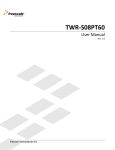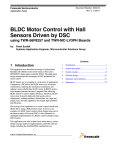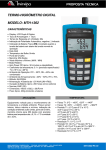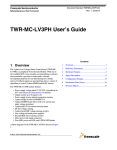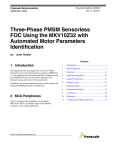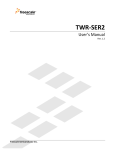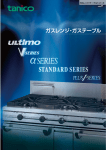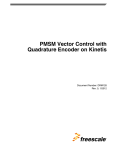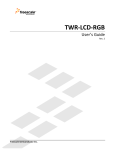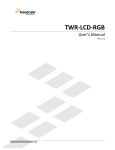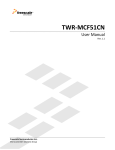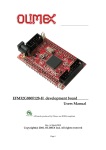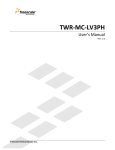Download Sensorless BLDC Motor Control Based on MC9S08PT60 Tower Board
Transcript
Freescale Semiconductor User Guide Document Number:S08PT60UG Rev. 0, 02/2013 Sensorless BLDC Motor Control Based on MC9S08PT60 Tower Board User Guide Contents 1 Overview 1 Overview....................................................................1 This user guide describes the basic steps for getting started with the sensorless BLDC motor control based on MC9S08PT60 Tower Board demo. The basic board function is described in this document. 2 Demo boards..............................................................3 3 Hardware feature.......................................................5 3.1 TWR-S08PT60...............................................5 The whole system is composed of TWR-S08PT60 and TWRMC-LV3PH (3-phase low voltage motor control board). 3.1.1 System power..................................5 3.1.2 Push buttons.....................................6 TWR-S08PT60 is a low-cost evaluation, demonstration and development board that features the 8-bit MC9S08PT60 microcontroller. The MC9S08P series are members of the low-cost, high-performance S08 family of 8-bit microcontroller units (MCUs). The MC9S08PT60 has up to 60 KB flash memory, 256 byte EEPROM, 4 KB RAM, and has a large set of peripherals including timers (3FTMs, 2 MTIMs), 3 SCIs (UARTs), 2 SPIs, I2C, ADC, ACMP, KBI, TSI, and others. 3.1.3 Potentiometer...................................6 3.1.4 Jumper tables...................................6 The following figure presents the block diagram of MC9S08PT60 Tower board. © 2013 Freescale Semiconductor, Inc. 3.2 TWR-MC-LV3PH..........................................8 3.2.1 Back EMF signals............................8 3.2.2 DC_Bus voltage signals...................8 3.2.3 DC_Bus current signals. ..................9 3.2.4 Jumper tables.................................10 4 Conclusions.............................................................10 5 Reference documents..............................................10 Overview Figure 1. TWR-S08PT60 block diagram The 3-phase Low Voltage Motor Control Board (TWR-MC-LV3PH) is a peripheral Tower System module. Figure 2 presents the block diagram of TWR-MC-LV3PH. Following are the features of the TWR-LV3PH. • Power supply voltage input 12-24 V DC, extended up to 50 V. • Output current up to 8 A • Power supply reverse polarity protection circuitry • 3-phase bridge inverter (6-MOSFETs) • 3-phase MOSFET gate driver with over current and under voltage protection • 3-phase and DC bus current-sensing shunts • DC bus-voltage sensing • 3-phase back-EMF voltage sensing circuitry • Encode / hall sensor sensing circuitry • Motor power and signal connectors • User LED, power-on LED, and 6 PWM LED diodes Sensorless BLDC Motor Control Based on MC9S08PT60 Tower Board, Rev. 0, 02/2013 2 Freescale Semiconductor, Inc. Demo boards Figure 2. TWR-MC-LV3PH block diagram 2 Demo boards The following figures depict the TWR-S08PT60 and TWR-MC-LV3PH demo boards labelled with the different components. Sensorless BLDC Motor Control Based on MC9S08PT60 Tower Board, Rev. 0, 02/2013 Freescale Semiconductor, Inc. 3 Demo boards Figure 3. TWR-S08PT60 demo board Figure 4. TWR-MC-LV3PH demo board Sensorless BLDC Motor Control Based on MC9S08PT60 Tower Board, Rev. 0, 02/2013 4 Freescale Semiconductor, Inc. Hardware feature 3 Hardware feature 3.1 TWR-S08PT60 3.1.1 System power The TWR-S08PT60 can be powered by the OSBDM circuit Mini-B USB connector when running in standalone mode. When assembled with the Tower System, the TWR-S08PT60 is powered by the Tower System Elevators. The mini-B USB connector is no longer used as a power source and is only used for OSBDM debugging purposes. When working in standalone mode, short pins 2 and 3 on J25 and J26 jumper blocks as the default setting. When working with the Tower System, short pins 1 and 2 on both J25 and J26 jumper blocks, as shown in the following figure. Figure 5. Power supply selection for standalone or Tower Elevator The PT60 can be powered by 5 V or 3.3 V power supply which is configurable via jumper J27. To use 5 V power supply, short pins 1 and 2 and to use 3.3 V power supply, short pins 2 and 3. See the following figure. Figure 6. Power supply selection for 5 V or 3.3 V Sensorless BLDC Motor Control Based on MC9S08PT60 Tower Board, Rev. 0, 02/2013 Freescale Semiconductor, Inc. 5 TWR-S08PT60 In this application, VDD_3V3_ELEV is selected as power supply according to TWR-MC-LV3PH’s configuration. So, short pins 1 and pin 2 of J26, and short pins 2 and 3 of J27. 3.1.2 Push buttons There are two general-purpose buttons which can be used to evaluate keyboard interrupts, and general switch inputs: SW2 and SW3. SW2 is connected to KBIP5 pin of PT60 and SW3 to KBIP4 pin of PT60. In addition, there is a reset button (SW4) used to reset PT60 and a force BDM button (SW1) used to manually force PT60 into BDM upon power up or reset. In this application, SW2 is used to increase speed. 3.1.3 Potentiometer Figure 7. TWR-S08PT60 potentiometer to ADC input A potentiometer is connected to the ADC input channel ADP0 through a jumper J7 as shown in Figure 7. In this application, the jumper J7 must be open, because DC_Bus current sample AD channel is conflicting with it. 3.1.4 Jumper tables The following table shows the jumper settings of TWR-S08PT60 demo board. Table 1. TWR-S08PT60 jumper settings Jumper Option Setting Description of MC9S08PT60 signal routing J1 UART2 selection 1–2 Connect RXD2 to OSBDM UART RX J2 UART2 selection 1–2 Connect TXD2 to OSBDM UART TX J3 ACMP1 Selection 1–2 ACMP1 is connected to Touch pad TWRPI pin18 of J8. 2–3 ACMP1 is optionally connected to motor control TWRPI pin15 of J10. 1–2 U1(ICL3232) pin 9 and pin 10 are shorted. J4 UART transceiver loop Table continues on the next page... Sensorless BLDC Motor Control Based on MC9S08PT60 Tower Board, Rev. 0, 02/2013 6 Freescale Semiconductor, Inc. TWR-S08PT60 Table 1. TWR-S08PT60 jumper settings (continued) Jumper Option Setting Description of MC9S08PT60 signal routing J5 UART/TSI/IRDA selection 1–2 UART1 TXD signal is connected to primary elevator A44. 2–3 UART1 TXD signal is connected to U1(ICL3232) pin11. 4–5 UART1 RXD signal is connected to primary elevator A43. 5–6 UART1 TXD signal is connected to U1(ICL3232) pin12. 7–8 PTB0/KBI0P4/RXD0/ADP4/TSI2 pin is connected to pin3 of J8. 8–9 PTB0/KBI0P4/RXD0/ADP4/TSI2 pin is connected to IRDA RX. 10–11 PTB1/KBI0P5/TXD0/ADP5/TSI3 pin is connected to pin5 of J8. 11–12 PTB1/KBI0P5/TXD0/ADP5/TSI3 pin is connected to IRDA TX. 13–14 Open 14–15 IRDA RX is connected to PTA1/KBI0P1/ FTM0CH1/ ACMP1/ADP1 pin. 1–2 Potentiometer is connected to PTA0/KBI0P0/ FTM0CH0/ACMP0/ADP0 pin. J7 PTA0/KBIP0/FTM0CH0/ACMP0/ ADP0 Pin selection open J9 J12 J13 OSBDM Boot loader mode or debugger mode selection 1–2 Slave Address (SA0 = 1) 0011101 (0x1D) 2–3 Slave Address (SA0 = 0) 0011100 (0x1C) 1–2 KBIP4 pin(PT60 pin44) is connected to U2(MMA8451Q) pin11 1–2 OSBDM IC in boot loader mode(For OSBDM firmware reprogramming) open OSBDM IC in debugger mode J15 KBIP4 Pin selection 1–2 KBIP4 pin(PT60 pin44) is connected to U2(MMA8451Q) pin11 J20 FTM2CH0 or TSI6 function selection 1–2 PTC0/FTM2CH0/ADP8/TSI6 pin is connected to pin9 of J8. 2–3 PTC0/FTM2CH0/ADP8/TSI6 pin is connected to pin14 of J11. 1–2 PTC1/FTM2CH1/ADP9/TSI7 pin is connected to pin10 of J8. 2–3 PTC1/FTM2CH1/ADP9/TSI7 pin is connected to pin15 of J11. 1–2 ADP15 pin is connected to pin 7 of J8. 2–3 ADP15 pin is connected to pin 17 of J8. 1–2 Elevator +5 V is connected to VDD_5V 2–3 USB +5 V is connected to VDD_5V. J21 J22 J25 FTM2CH1or TSI7 function selection ADP15 Pin selection VDD_5 selection Table continues on the next page... Sensorless BLDC Motor Control Based on MC9S08PT60 Tower Board, Rev. 0, 02/2013 Freescale Semiconductor, Inc. 7 TWR-MC-LV3PH Table 1. TWR-S08PT60 jumper settings (continued) Jumper Option Setting Description of MC9S08PT60 signal routing J26 VDD_3P3 selection 1–2 Elevator +3.3 V is connected to VDD_3P3 2–3 LDO U4 output voltage +3.3 V is connected to VDD_3P3 1–2 VDD_PULL is connected to +5 V. 2–3 VDD_PULL is connected to +3.3 V. J27 VDD_PULL selection J28 Reset signal for MC9S08PT60 1–2 Reset signal is connected to RESET pin. J29 MC9S08PT60 Power Supply 1–2 VDD is connected to VDD_PULL. In addition to the above mentioned, other jumper’s configuration is default. For more information, see TWRS08PT60UM: TWR-S08PT60 User Manual, available on freescale.com. 3.2 TWR-MC-LV3PH 3.2.1 Back EMF signals Figure 8. BEMF detect circuit for Phase A Figure 8 is back EMF detect circuit of phase A, phase B, and phase C are the same. In this demo, short pins 2 and 3 of the jumpers J11, J12, and J13, otherwise, sample value is phase current value instead of BEMF value. 3.2.2 DC_Bus voltage signals Sensorless BLDC Motor Control Based on MC9S08PT60 Tower Board, Rev. 0, 02/2013 8 Freescale Semiconductor, Inc. TWR-MC-LV3PH Figure 9. DC_Bus voltage detect circuit Figure 9 is DC_Bus voltage detect circuit. In this demo, short pins 2 and 3 of the jumper J14, otherwise, sample value is phase A current value instead of V_SENSE_DCB_HALF. 3.2.3 DC_Bus current signals Figure 10. DC_Bus current detect circuit Figure 10 is DC_Bus current detect circuit. Sensorless BLDC Motor Control Based on MC9S08PT60 Tower Board, Rev. 0, 02/2013 Freescale Semiconductor, Inc. 9 Conclusions In this demo, short pins 2 and 3 of the jumper J13, otherwise, sample value is phase C current value instead of I_SENSE_DCB. 3.2.4 Jumper tables Table 2. TWR-MC-LV3PH jumper settings Jumpers Options Setting Description of TWR-MC-LV3PH J2 VDDA Source Select 1–2 Internal on-board source of analog 3.3 V J3 VSSA Source Select J10 AN2 Signal Select J11 AN1 Signal Select J12 AN0 Signal Select J13 J14 AN6 Signal Select AN56 Signal Select 2–3 Elevator source of analog 3.3 1–2 Internal on-board source of analog GND 2–3 Elevator source of analog GND 1–2 Phase C current signal 2–3 Back EMF phase C 1–2 Phase B current signal 2–3 Back EMF phase B 1–2 Phase A current signal 2–3 Back EMF phase A 1–2 Phase C current signal 2–3 DC Bus Current 1–2 Phase A current signal 2–3 DC Bus Half Voltage In addition to the above mentioned, other jumpers' configuration is default. For more information, see TWR-MC-LV3PH User’s Manual, available on freescale.com. 4 Conclusions This document described the basic steps for getting started with the sensorless BLDCM control based on MC9S08PT60 tower board and its demo suitcase. 5 Reference documents For the latest revision of all the Tower documents listed below, visit freescale.com. • TWR-S08PT60 Design Package • TWRS08PT60QSG: TWR-S08PT60 Quick Start Guide • TWR-S08PT60-LABS: TWR-S08PT60 Labs • TWRS08PT60UM: TWR-S08PT60 User Manual • MC9S08PT60RM: MC9S08PT60 Reference Manual • MC9S08PT60 : MC9S08PT60 Series Data Sheet • TWRMCLV3PHUG : TWR-MC-LV3PH User’s Guide • TWR-MC-LV3PH Design Package Sensorless BLDC Motor Control Based on MC9S08PT60 Tower Board, Rev. 0, 02/2013 10 Freescale Semiconductor, Inc. How to Reach Us: Home Page: www.freescale.com Web Support: http://www.freescale.com/support USA/Europe or Locations Not Listed: Freescale Semiconductor Technical Information Center, EL516 2100 East Elliot Road Tempe, Arizona 85284 +1-800-521-6274 or +1-480-768-2130 www.freescale.com/support Europe, Middle East, and Africa: Freescale Halbleiter Deutschland GmbH Technical Information Center Schatzbogen 7 81829 Muenchen, Germany +44 1296 380 456 (English) +46 8 52200080 (English) +49 89 92103 559 (German) +33 1 69 35 48 48 (French) www.freescale.com/support Japan: Freescale Semiconductor Japan Ltd. Headquarters ARCO Tower 15F 1-8-1, Shimo-Meguro, Meguro-ku, Tokyo 153-0064 Japan 0120 191014 or +81 3 5437 9125 [email protected] Asia/Pacific: Freescale Semiconductor China Ltd. Exchange Building 23F No. 118 Jianguo Road Chaoyang District Beijing 100022 China +86 10 5879 8000 [email protected] Document Number: S08PT60UG Rev. 0, 02/2013 Information in this document is provided solely to enable system and software implementers to use Freescale Semiconductors products. There are no express or implied copyright licenses granted hereunder to design or fabricate any integrated circuits or integrated circuits based on the information in this document. Freescale Semiconductor reserves the right to make changes without further notice to any products herein. Freescale Semiconductor makes no warranty, representation, or guarantee regarding the suitability of its products for any particular purpose, nor does Freescale Semiconductor assume any liability arising out of the application or use of any product or circuit, and specifically disclaims any liability, including without limitation consequential or incidental damages. "Typical" parameters that may be provided in Freescale Semiconductor data sheets and/or specifications can and do vary in different applications and actual performance may vary over time. All operating parameters, including "Typicals", must be validated for each customer application by customer's technical experts. Freescale Semiconductor does not convey any license under its patent rights nor the rights of others. Freescale Semiconductor products are not designed, intended, or authorized for use as components in systems intended for surgical implant into the body, or other applications intended to support or sustain life, or for any other application in which failure of the Freescale Semiconductor product could create a situation where personal injury or death may occur. Should Buyer purchase or use Freescale Semiconductor products for any such unintended or unauthorized application, Buyer shall indemnify Freescale Semiconductor and its officers, employees, subsidiaries, affiliates, and distributors harmless against all claims, costs, damages, and expenses, and reasonable attorney fees arising out of, directly or indirectly, any claim of personal injury or death associated with such unintended or unauthorized use, even if such claims alleges that Freescale Semiconductor was negligent regarding the design or manufacture of the part. RoHS-compliant and/or Pb-free versions of Freescale products have the functionality and electrical characteristics as their non-RoHS-complaint and/or non-Pb-free counterparts. For further information, see http://www.freescale.com or contact your Freescale sales representative. For information on Freescale's Environmental Products program, go to http://www.freescale.com/epp. Freescale™ and the Freescale logo are trademarks of Freescale Semiconductor, Inc. All other product or service names are the property of their respective owners. © 2013 Freescale Semiconductor, Inc.











